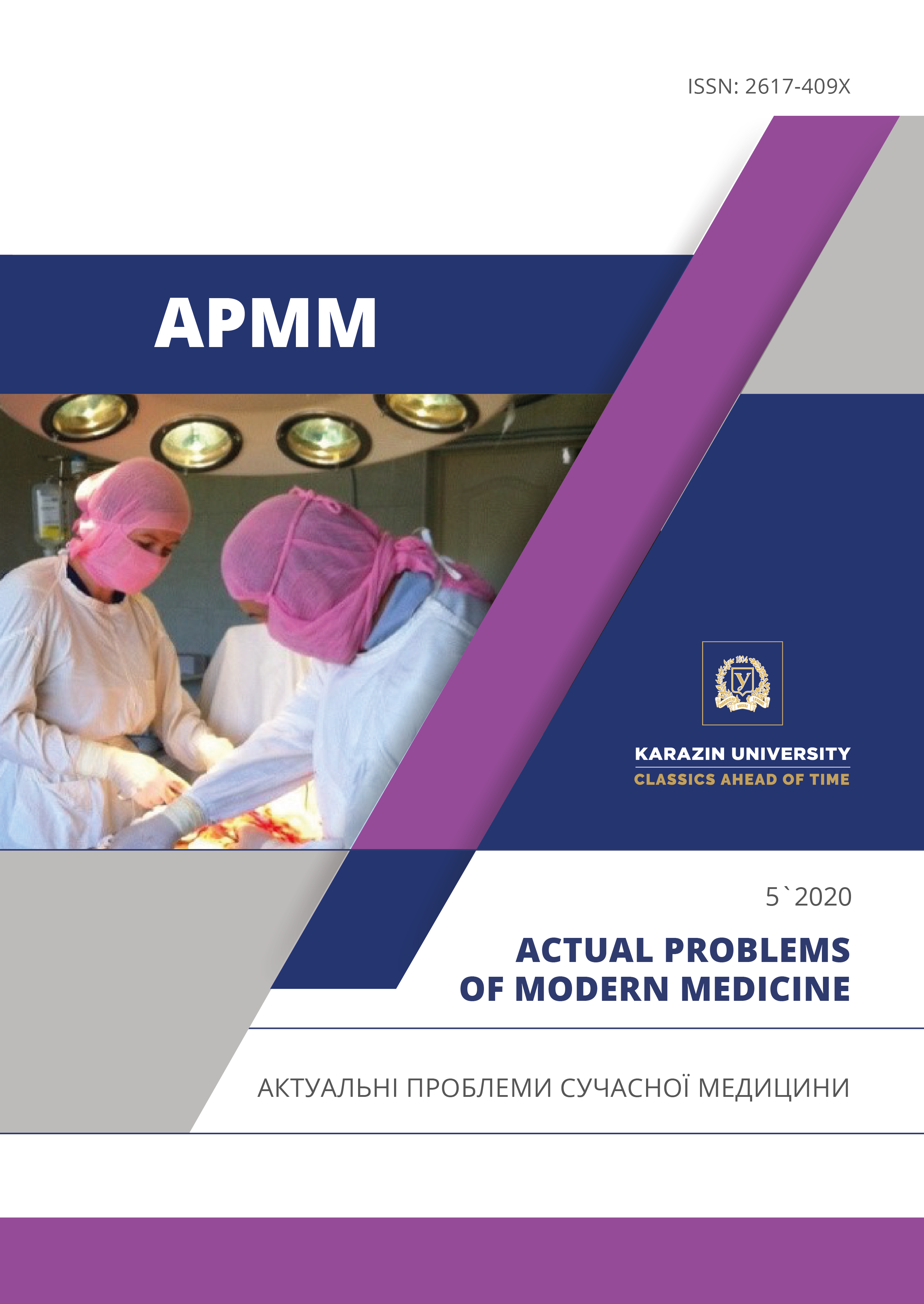Можлива роль бактеріального вагінозу в патогенезі передракових захворювань шийки матки
Анотація
Відома роль папіломавірусної інфекції у виникненні передракових захворювань і раку шийки матки. Бактеріальний вагіноз, що призводить до дефіциту імунного захисту на рівні слизової піхви, є частим супутником папіломавірусної інфекції. Було проведено вивчення можливої ролі бактеріального вагінозу в патогенезі цервікальної інтраепітеліальної неоплазії і раку шийки матки у пацієнток із папіломавірусної інфекцією. Кольпоскопія і онкоцитологія необхідні в оцінці передракових процесів шийки матки. Біопсія використовується для підтвердження діагнозу, тим самим зменшуючи інвазивність лікування і пов'язаних з ним ускладнень. Усього було обстежено 126 жінок репродуктивного віку, 30 з яких були практично здоровими і склали І групу. У II групі під спостереженням перебувало 46 жінок з патологічними процесами шийки матки та папіломавірусної інфекцією. У III групі було 50 пацієнток із захворюваннями шийки матки, папіломавірусної інфекцією і бактеріальним вагінозом. Обстеженим в роботі пацієнткам проводили бактеріоскопію вагінальних виділень, кольпоскопію, онкоцитологію, кількісне визначення і типування коменсалів піхви методом полімеразної ланцюгової реакції. В результаті проведеної роботи було встановлено, що навіть при нормальному типі онкоцітологічного мазку в 17,7 % пацієнток відзначався хронічний цервіцит, а у 11,5 % – цервікальна інтраепітеліальна неоплазія. Чутливість цитологічних мазків по Папаніколау щодо діагностики цервікальної інтраепітеліальної неоплазії і раку шийки матки була 86,5%, а специфічність – 70,0 %. Частота цервікальної інтраепітеліальної неоплазії і раку шийки матки склала в ІII і II групах 42,0 % і 23,3 %, відповідно. Наявність бактеріального вагінозу в пацієнток з папіломавірусної інфекцією є фактором, який підвищував ризик виявлення цервікальної інтраепітеліальної неоплазії і раку шийки матки на 15,8 %. Даний результат демонструє необхідність подальшого вивчення порушень вагінального біотопу у жінок з папіломавірусної інфекцією і асоційованих з нею цервікальної інтраепітеліальної неоплазією і раком шийки матки.
Завантаження
Посилання
Boccardo, E., Lepique, A. P., Villa, L. L. (2010). The role of inflammation in HPV carcinogenesis. Carcinogenesis, 31, 1905–1912. DOI: 10.1093/carcin/bgq176
Zorzi, M., Del Mistro, A., Farruggio, A., et al. (2013). Use of a high-risk human papillomavirus DNA test as the primary test in a cervical cancer screening programme: a population-based cohort study. BJOG, 120 (10), 1260–1267. DOI: 10.1111/1471-0528.12272
Dahoud, W., Michael, C. W., Gokozan, H., et al. (2019). Association of Bacterial Vaginosis and Human Papilloma Virus Infection With Cervical Squamous Intraepithelial Lesions. Am J Clin Pathol, 152 (2), 185-189. DOI: 10.1093/ajcp/aqz021
Lakhno, I. V. (2016). Treatment of Genital Warts: Focus on Vaginal Dysbiosis. Reproductive Endocrinology, 28(1), 30-32. DOI: http://dx.doi.org/10.18370/2309-4117.2016.27.30-32
Chrysostomou, A. C., Stylianou, D. C., Constantinidou, A., Kostrikis, L. G. (2018). Cervical Cancer Screening Programs in Europe: The Transition Towards HPV Vaccination and Population-Based HPV Testing. Viruses, 10 (12), E729. DOI: 10.3390/v10120729
Yi, Y., Fang, Y., Wu, K., et al. (2020). Comprehensive gene and pathway analysis of cervical cancer progression. Oncol Lett, 19 (4), 3316–3332. DOI: 10.3892/ol.2020.11439.
Barros, M. R., Jr, de Melo C. M. L., Barros, M. L., et al. (2018). Activities of stromal and immune cells in HPV-related cancers. J Exp Clin Cancer Res,5, No3 7(1), 137. DOI: 10.1186/s13046-018-0802-7.
Romero-Morelos, P., Bandala, C., Jiménez-Tenorio, J., et al. (2019). Vaginosis-associated Bacteria and Its Association With HPV Infection Observational Study. Med Clin (Barc), 152 (1), 1-5. DOI: 10.1016/j.medcli.2018.01.027.
Smith, R. A., Andrews, K. S., Brooks, D., et al. (2018). Cancer screening in the United States, 2018: A review of current American Cancer Society guidelines and current issues in cancer screening. CA Cancer J Clin, 68 (4), 297–316. DOI: 10.3322/caac.21446.
Ferreira, C. S. T., Donders, G. G., Parada, C. M. G. L., et al. (2017). Treatment failure of bacterial vaginosis is not associated with higher loads of Atopobium vaginae and Gardnerella vaginalis. J Med Microbiol, 66 (8), 1217–1224. DOI: 10.1099/jmm.0.000561
Massad, L. S. (2018). Methods of Screening for Cervical Cancer-Reply. JAMA, 320 (18), 1939. DOI: 10.1001/jama.2018.13943
Ortashi, O., Abdalla, D. (2019). Colposcopic and Histological Outcome of Atypical Squamous Cells of Undetermined Significance and Atypical Squamous Cell of Undetermined Significance Cannot Exclude High-Grade in Women Screened for Cervical Cancer. Asian Pac J Cancer Prev, 20 (9), 2579–2582. DOI: 10.31557/APJCP.2019.20.9.2579
Sawaya, G. F., Smith-McCune, K., Kuppermann, M. (2019). Cervical Cancer Screening: More Choices in 2019. JAMA, 321 (20), 2018–2019. DOI: 10.1001/jama.2019.4595
Stoler, M. H., Vichnin, M. D., Ferenczy, A., et al. (2011). The accuracy of colposcopic biopsy: Analyses from the placebo arm of the Gardasil clinical trials. Int J Cancer, 128, 1354–1362. DOI: 10.1002/ijc.25470
Trevethan, R. (2017). Sensitivity, Specificity, and Predictive Values: Foundations, Pliabilities, and Pitfalls in Research and Practice. Front Public Health, 5, 307. DOI: 10.3389/fpubh.2017.00307
Vorobiova, L. I., Dunaievska, V. V., Koshmerynska, A. M. (2015). Pathogenetic Therapy of Cervical Intraepithelial Neoplasia II-III. Reproductive Endocrinology, 24 (4), 74-77. DOI:10.18370/2309-4117.2015.24.74-77
Frazer, I. H. (2019). The HPV Vaccine Story. ACS Pharmacol Transl Sci, 2 (3), 210–212. DOI: 10.1021/acsptsci.9b00032
Athanasiou, A., Veroniki, A. A., Efthimiou, O., et al. (2019). Comparative fertility and pregnancy outcomes after local treatment for cervical intraepithelial neoplasia and stage 1a1 cervical cancer: protocol for a systematic review and network meta-analysis from the CIRCLE group. BMJ Open, 9 (10), e028009. DOI: 10.1136/bmjopen-2018-028009
Mazur, Yu. Yu., Pyrohova, V. I., Kuz, N. M. (2018). Vaginal Biocenosis State Assessment in Patients With Cervical Ectopy Relapse in the Conditions of Human Papillomavirus Infection. Health of Woman, 5 (132), 37–41. DOI: 10.15574/HW.2018.132.37
Romanenko, T. G., Dovbnia, T. V. (2018). Papillomаvirus Infection of the Genitals (Clinical Lecture). Health of Woman, 2 (128), 9–15. DOI 10.15574/HW.2018.128.9




